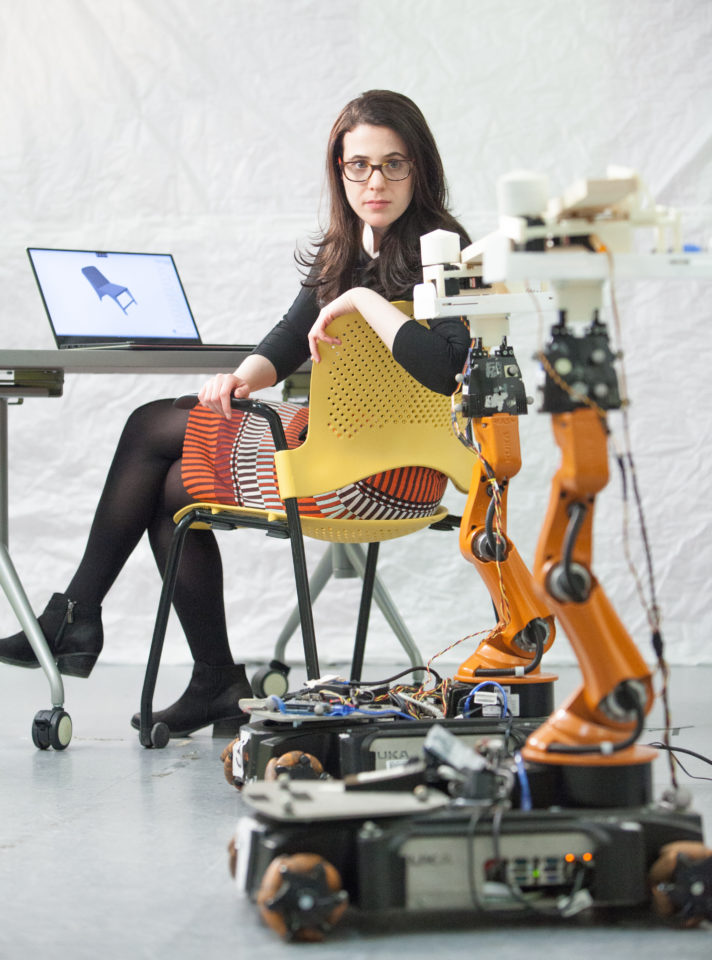While carpentry has gotten safer over the years, a group of engineers from MIT want to reduce the risk of lost fingers, cuts and bruises even further. The team’s new finger-saving system also modified commonly found technology, including pieces from the famous automated vacuuming robot Roomba.
copyright by interestingengineering.com
 The AutoSaw robot system allows non-skilled wannabe carpenters design the furniture they want in a safe, secure environment. The system gives users the ability to customize a range of carpenter-designed templates for chairs, desks, and other furniture, according to a university press release. The AutoSaw can even be used for larger projects like building a back porch.
The AutoSaw robot system allows non-skilled wannabe carpenters design the furniture they want in a safe, secure environment. The system gives users the ability to customize a range of carpenter-designed templates for chairs, desks, and other furniture, according to a university press release. The AutoSaw can even be used for larger projects like building a back porch.
“If you’re building a deck, you have to cut large sections of lumber to length, and that’s often done on site,” said Computer Science and Artificial Intelligence Laboratory (CSAIL) postdoc Jeffrey Lipton, who was a lead author on a related paper about the system. “Every time you put a hand near a blade, you’re at risk. To avoid that, we’ve largely automated the process using a chop-saw and jigsaw.”
The system even gives users the ability to custom fit their furniture into uniquely-shaped houses and spaces. The MIT team said it would even give someone the ability to create an interesting table to fit a micro-kitchen space.
The system works by expanding upon carpentry’s Computer Numerical Control (CNC) system — software that’s far from foreign to many carpenters. The problem with CNC, however, is that the tools used to execute those designs are often cumbersome. The size of those ‘custom’ gadgets often lead to carpenters opting out of the software and using hand tools that pose a higher risk of injury.
However, the AutoSaw could combine the precision of software with the maneuverability of hand tools. It leverages years of expert knowledge about design and leaves robots to do the riskier parts of the building. It uses CAD OnShape for design purposes. Once a user is happy with their design, they can send it to the robotic system to bring those designs to reality. […]
read more – copyright by interestingengineering.com


While carpentry has gotten safer over the years, a group of engineers from MIT want to reduce the risk of lost fingers, cuts and bruises even further. The team’s new finger-saving system also modified commonly found technology, including pieces from the famous automated vacuuming robot Roomba.
copyright by interestingengineering.com
“If you’re building a deck, you have to cut large sections of lumber to length, and that’s often done on site,” said Computer Science and Artificial Intelligence Laboratory (CSAIL) postdoc Jeffrey Lipton, who was a lead author on a related paper about the system. “Every time you put a hand near a blade, you’re at risk. To avoid that, we’ve largely automated the process using a chop-saw and jigsaw.”
The system even gives users the ability to custom fit their furniture into uniquely-shaped houses and spaces. The MIT team said it would even give someone the ability to create an interesting table to fit a micro-kitchen space.
The system works by expanding upon carpentry’s Computer Numerical Control (CNC) system — software that’s far from foreign to many carpenters. The problem with CNC, however, is that the tools used to execute those designs are often cumbersome. The size of those ‘custom’ gadgets often lead to carpenters opting out of the software and using hand tools that pose a higher risk of injury.
However, the AutoSaw could combine the precision of software with the maneuverability of hand tools. It leverages years of expert knowledge about design and leaves robots to do the riskier parts of the building. It uses CAD OnShape for design purposes. Once a user is happy with their design, they can send it to the robotic system to bring those designs to reality. […]
read more – copyright by interestingengineering.com
Share this: